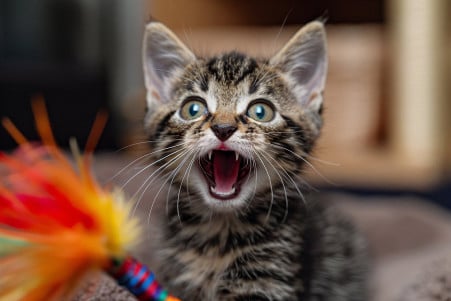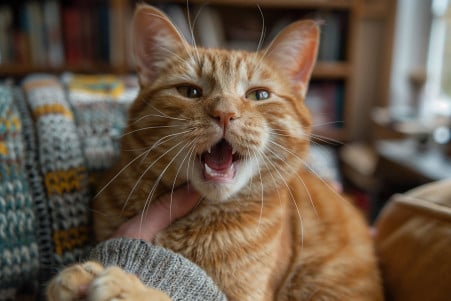Why Does My Cat Chew on My Fingers? Understanding Cat Behavior
5 April 2024 • Updated 4 April 2024

While it can be an annoying and even painful behavior, knowing why your cat is chewing on your fingers can help you stop it. Cats may chew on their owners' fingers to mark their territory with their scent, as a form of play that they learned as kittens, or to get attention from their owners. To stop the behavior, make sure your cat isn't bored, offer them other things to chew on, and use positive reinforcement to encourage the behavior you want to see.
By delving into the scientific studies of animal behaviorists and veterinarians, we will learn about the many reasons why cats may chew on their owners' fingers. This will help us understand the psychological and physiological factors that drive this behavior, enabling us to better understand what our cats are trying to communicate. With this information, we can then work to redirect any unwanted chewing through positive training that speaks to our cats' instincts and rewards them for good behavior.
Why does my cat chew on my fingers?
Why Cats Chew and Bite During Play
A cat's inclination to chew or bite during play can be traced back to their natural hunting instincts. According to PurrfectPost.com, kittens learn to use their teeth and paws through wrestling and play-biting with their littermates, which is similar to how they will stalk, grab, and bite their prey as adults. Even when they're fully grown, cats may continue to chew and bite to fulfill their predatory needs, as mentioned in this Purina article.
Chewing, biting, and bunny kicking during play also help cats practice important hunting techniques like stalking, catching, and delivering a killing bite. While this may be worrisome to cat parents, these behaviors are a normal part of a cat's genetic makeup. As The Humane Society points out, kittens who are weaned too early may not learn how to control their bites from their mothers.
The key is to offer cats alternative ways to express these natural instincts. Playing with cats using interactive wand toys, kick toys, and throwing toys, for example, will give them the opportunity to stalk, pounce, and "kill" without putting human skin at risk. This type of play will help cats fulfill their hunting needs without reinforcing negative biting behaviors.
Dealing With Petting-Induced Aggression and Overstimulation
One of the most common reasons for petting-induced aggression is overstimulation. According to The Spruce Pets, this is often due to the cat's low tolerance for prolonged physical contact. Signs of overstimulation include tail flicking, ear rotation, and a stiff body.
Meanwhile, PetMD notes that it's important for cat owners to be able to tell the difference between love bites and actual bites. Actual bites are more intense and are a sign of aggression or fear, and they're often accompanied by other aggressive behaviors. Love bites, on the other hand, are a lighter, more affectionate form of biting.
To avoid petting-induced aggression, the Humane Society of Huron Valley suggests that pet parents pay attention to the warning signs and adjust petting sessions accordingly. In addition, making sure that cats have opportunities to play and release energy can help reduce overstimulation and the likelihood of biting.
Positive Reinforcement and Training Techniques
Positive reinforcement training can help deter cats from chewing and biting. According to Purina, clicker training, target training, and rewarding good behavior are all ways to train a cat out of certain behaviors. When a cat does bite, it's important to redirect them calmly or use a short verbal correction, but not punishment, according to BetterPet.
By setting up the right training environment and using positive reinforcement, you can help your cat learn the right boundaries and behaviors. For example, according to Zoetis Petcare, when a kitten bites during play, you can immediately stop playing and avoid big reactions to show them that biting leads to the end of play. Then, you can reward them for gentle play and redirect them to toys to show them what behavior you want to see.
These positive training methods can help cat owners stop biting and chewing while also building a stronger relationship with their cats. This is important when it comes to addressing more serious biting issues, especially in kittens who are teething.
How to Stop Kitten Biting and Teething
Kittens bite and chew to explore their world and to help alleviate the pain of teething, according to The Spruce Pets. However, kittens that have been separated from their mothers and littermates too soon may not have learned how to control their biting, according to HomesAlive.ca.
To help stop biting and chewing on human fingers, make sure your kitten has a variety of toys to chew on and redirect them when they start to bite or chew on your fingers. Feliway suggests using toys that you can hold at a distance from your kitten, like a feather on a string, to help them learn that hands are not for biting. It takes time and patience, but with consistent training, you can help your kitten learn to control their biting, according to Zoetis Petcare.
While biting and chewing may be more common in kittens due to their natural curiosity and teething, these behaviors can be nipped in the bud with positive reinforcement. By providing appropriate outlets and reinforcing gentle play, owners can help ensure their kittens grow into well-behaved cats.
Medical and Psychological Causes
In some cases, biting and chewing can be a sign of a medical or psychological issue. According to AskVet, if medical issues have been ruled out, owners may need to consult a veterinary behaviorist to understand the root cause of their cat's biting behavior.
According to the Merrimack River Feline Rescue Society, stress, anxiety, fear, or pain can all be reasons for aggressive or attention-seeking biting. It's important to make sure that there are no medical or environmental causes for the behavior. For example, BetterVet explains that sudden changes in a cat's behavior, including biting, can be a sign of an underlying illness or pain.
If the biting doesn't improve after addressing environmental and training causes, a veterinarian or animal behaviorist may be able to help determine if there are any medical or psychological causes that need to be treated. With the right help, cat owners can work to understand the cause of the biting and find solutions that will help them have a positive relationship with their cat.
Conclusion: How to Form a Positive Relationship With Your Cat
There are many reasons why a cat might bite. According to The Spruce Pets, adult cats may bite due to fear, to show dominance, or to get attention. Meanwhile, kittens bite, mouth, and paw at things to explore their environment, but they should have learned to control these behaviors through interactions with their mother and littermates.
If a kitten is taken away from its family too soon, it won't have the chance to learn this important lesson, and the responsibility of teaching the kitten how to interact appropriately will fall to the owner, according to Catster. Biting can also be a sign of overstimulation, pain, or fear, so it's important for owners to be aware of their cat's body language and to make sure they're not pushing their cat past its limits.
Positive reinforcement training, making sure cats have a way to express their natural hunting instincts, and making sure any medical or psychological issues are being treated can all help to stop biting. With time and effort, owners can form a strong, positive relationship with their cats.


